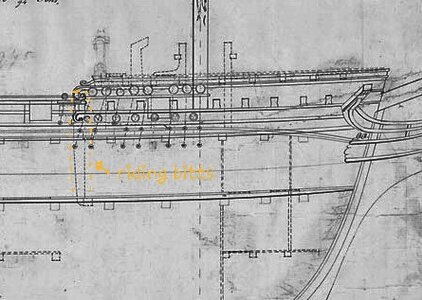If I'm reading it right Steele and Goodwin both say that there were two riding bitts about 12 feet apart. All the original drawings I have of the Discovery1789 only show one. Mind you my drawings are rather incomplete. Did non navy ships possibly have only one bitts? Even if a ship was built with one do you think the Navy would have upgraded that to two when they purchased a ship? I do have a John McKay drawing that shows two but I think he was working with the same drawings I have so I'm guessing he was using an educated guess?
You are using an out of date browser. It may not display this or other websites correctly.
You should upgrade or use an alternative browser.
You should upgrade or use an alternative browser.
- Joined
- Aug 8, 2019
- Messages
- 4,195
- Points
- 688

massive bitts formerly used to secure the anchor cables of a ship riding at anchor -riding bitts, Webster.
I think that Steel telling the thruth about this. His book discribe the seamansships practise how things are done.
If I understand your question right.
I think that Steel telling the thruth about this. His book discribe the seamansships practise how things are done.
If I understand your question right.
I guess what I'm asking is has anyone seen a ship with only one riding bitt(s)? None of the Discovery1789 drawings I have show two riding bitts And I don't know who/what to believe. I would tend to believe the drawings but the best one is labeled as incomplete and the others are for conversions to a bomb ship and and I'm not sure if they would concern themselves with the riding bitts.
- Joined
- Aug 8, 2019
- Messages
- 4,195
- Points
- 688

Not every ship is the same, have different styles in build.
You asked this question before
and you tought it was the camber of the beams. But when you search on Maria Webster it is a big post to lay ropes on.
In the drawing could be show one, because the other one is on the other side of the ship. What says the drawing from above. When it is placed in the middle of the ship it is just one.
Or are you still talking about the camber?
Maybe when you post a picture of the part you mean, and the part of text of Steel and Godwin. Name the book and page is also okay. When your question is clear we can help. Because the question you now ask makes no sence to the question you asked before and was answer by Uwe
You asked this question before
Bitts question
This is a picture of the riding bitts of the Discovery1789. It is from a drawing for the initial modifications for the journey to the west coast. The red is existing and the green is proposed. They were raising the QD and forecastle I believe. What I'm confused about is the beams that the bitts...
shipsofscale.com
In the drawing could be show one, because the other one is on the other side of the ship. What says the drawing from above. When it is placed in the middle of the ship it is just one.
Or are you still talking about the camber?
Maybe when you post a picture of the part you mean, and the part of text of Steel and Godwin. Name the book and page is also okay. When your question is clear we can help. Because the question you now ask makes no sence to the question you asked before and was answer by Uwe
Sorry for this. Not the same question.
Goodwin "English Man of War" pg 175
A picture of a pair of bitts and in the text it says "the fore set abaft the foremast and the after set approx 12 ft aft of the fore bitts"
Yedlinski "Scantlings of Royal Navy Ships" folio 35
Lines "B and C" "foremost and after ones"
You can see in the drawings that there is only one bitt. Hope that's easier to understand
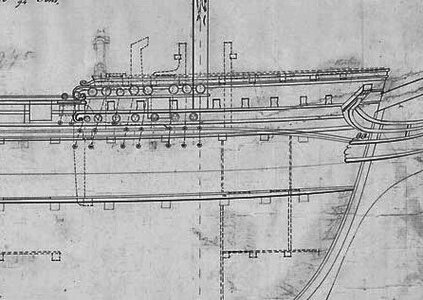
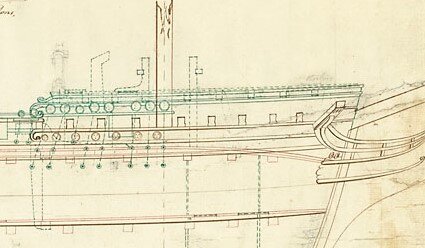
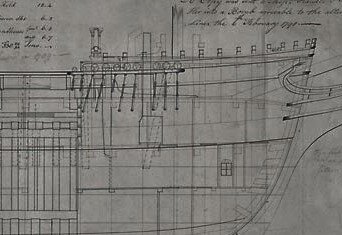
.
Goodwin "English Man of War" pg 175
A picture of a pair of bitts and in the text it says "the fore set abaft the foremast and the after set approx 12 ft aft of the fore bitts"
Yedlinski "Scantlings of Royal Navy Ships" folio 35
Lines "B and C" "foremost and after ones"
You can see in the drawings that there is only one bitt. Hope that's easier to understand



.
I don't understand. The bitts are on the centerline of the ship. There are no port or starboard bitts, only fore and aft.
Hello Don, are you talking about riding bitts or Topsail sheet bitts?I don't understand. The bitts are on the centerline of the ship. There are no port or starboard bitts, only fore and aft.
The word 'bitt' indicates the column usually with shaves. the purpose of this bitt is varies depending on where this bit is located. Sure it can be bort and starboard.
The massive riding bitts usually stood on the upper or middle deck below the forecastle, level with hawse holes. Their task was to secure the cables; on the larger ships were usually two riding bitts, one behind the other.Sorry for this. Not the same question.
Goodwin "English Man of War" pg 175
A picture of a pair of bitts and in the text it says "the fore set abaft the foremast and the after set approx 12 ft aft of the fore bitts"
The vertical posts passed down through the decks as far as the footwaling or ceiling into which they were stepped. Towards the bow, they were supported, with two long, powerful knees or standards which were securely fixed to the deck beams by means of long bolts.
On smaller ships, riding bitts were exposed on the main deck and were often combined with the windlass.
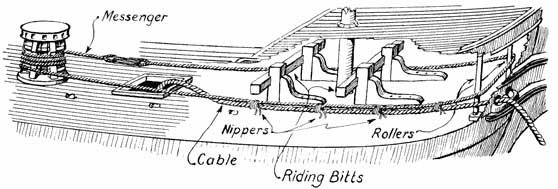
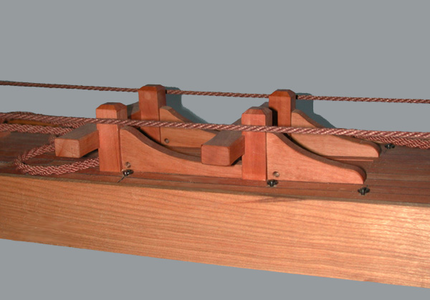
Riding bitts, like the title of this thread
I thought I'd hit post so this is a little late
I thought I'd hit post so this is a little late
Yes Jim. notice that their is a pair. What I'm wondering is if there was ever just one.The massive riding bitts usually stood on the upper or middle deck below the forecastle, level with hawse holes. Their task was to secure the cables; on the larger ships were usually two riding bitts, one behind the other.
The vertical posts passed down through the decks as far as the footwaling or ceiling into which they were stepped. Towards the bow, they were supported, with two long, powerful knees or standards which were securely fixed to the deck beams by means of long bolts.
On smaller ships, riding bitts were exposed on the main deck and were often combined with the windlass.
View attachment 290167
View attachment 290168
I really appreciate you guys trying to help. I always think I'm asking simple questions but they always seem to end up complicated. I must ask them wrong or something.
The simple answer is: on large ships they are always in pairs, on small ships - just one, on the main deck.Yes Jim. notice that their is a pair. What I'm wondering is if there was ever just one.
Thank you very much Jim. I hate to be a pain but just one more question for now. At 330 tons and about 100 ft long do you think the Discovery1789 would be a small ship? Where would the cutoff be between large and small?
- Joined
- Aug 8, 2019
- Messages
- 4,195
- Points
- 688

I was thinking on a mooring bitts. Bitts are used when a ship goes to anchor. Like a mooring bitts. These are most in pairs. That is what mediamarkt webster give as explanation to riding bitts
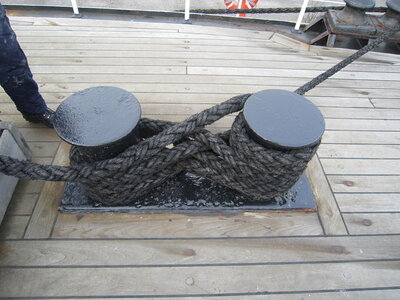

Bitts vs. Bollard — What’s the Difference?
Bitts are pairs of posts on the deck of a ship for fastening ropes, while a bollard is a short, sturdy vertical post often used on docks or streets.
www.askdifference.com
Thank you for your interest Stephan, any help is better than no help. I'm slowly realizing that I've bitten off a mouthful with this project. With just 7 drawings in existence there is not a lot to go by. I have a few John McKay drawings but they were just derived from the original 7 so anything he added was speculation(although knowledgeable speculation ). I'm left with trying to figure out how a ship like this was put together. Tough go for my first ship. But unfortunately I'm not a quitter so I'm stuck with bothering people on forums like this to figure it out. I'm gathering a few books but most of them are aimed at larger military vessels so there is going to be some differences. Anyway thanks for helping Stephan and Jim and anyone else that has helped me in my quest.
). I'm left with trying to figure out how a ship like this was put together. Tough go for my first ship. But unfortunately I'm not a quitter so I'm stuck with bothering people on forums like this to figure it out. I'm gathering a few books but most of them are aimed at larger military vessels so there is going to be some differences. Anyway thanks for helping Stephan and Jim and anyone else that has helped me in my quest.
Now I have to fix the two holes in the lower deck that I cut for the forward riding bitts.
'
'
Now I have to fix the two holes in the lower deck that I cut for the forward riding bitts.
'
'
Compared to HMS Victory or another Three-decker, Discovery is a relatively small ship. Unfortunately, the ships were never classified as small, medium, large, and extra-large. It will be impossible to make a cutoff between Large and small. The 'small' ship in my response is a relative value, though.Thank you very much Jim. I hate to be a pain but just one more question for now. At 330 tons and about 100 ft long do you think the Discovery1789 would be a small ship? Where would the cutoff be between large and small?
Think of the number of anchors she carried, the weights of the 'bowers'. This all information may lead you to believe that the second bitts are not really required.
Thank you Jim. I think I've decided to go with the drawings. They all show one bitt. John McKay showed two but I'm thinking in this case that he was wrong. I kind of hate to decide that as he obviously knows more than me but the evidence seems to be against it. Judgement call I guess.
Thanks for all your help.
Thanks for all your help.



